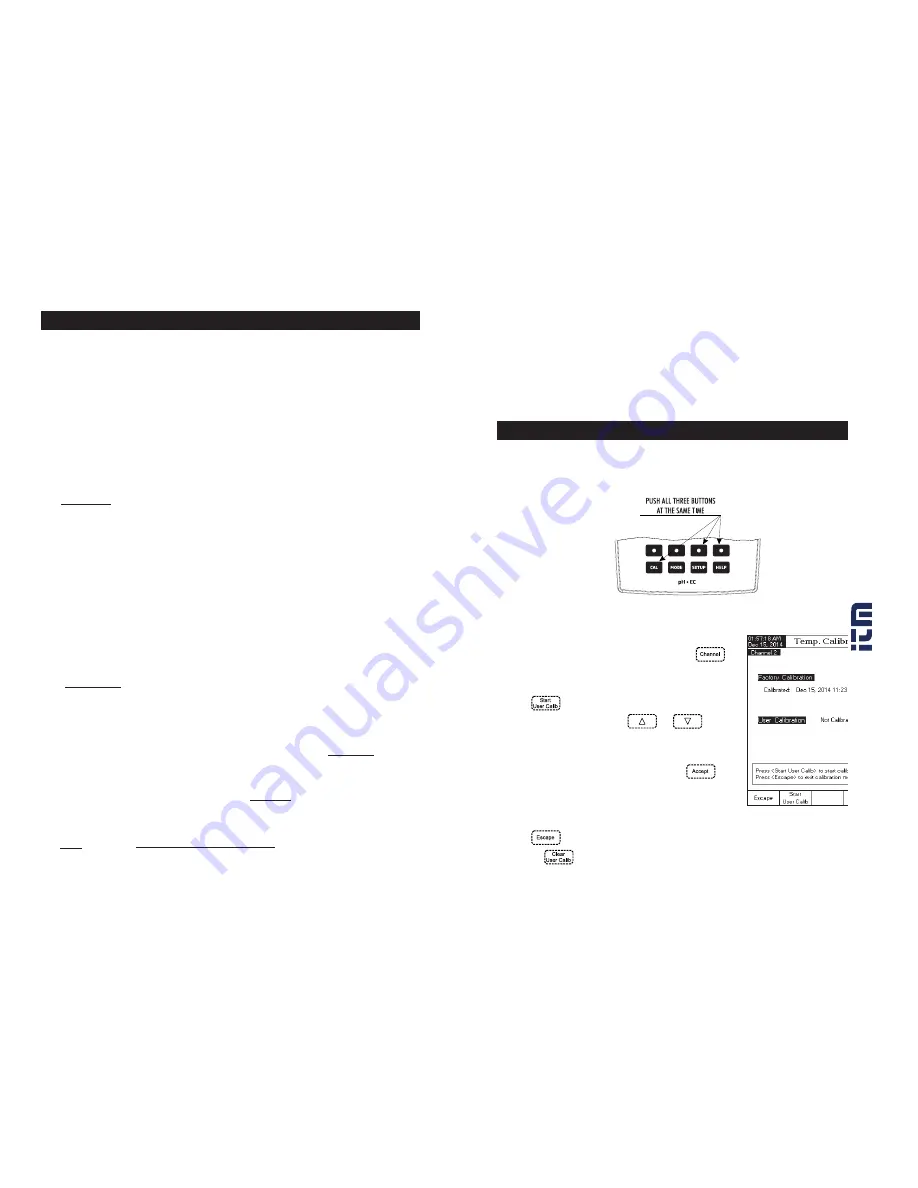
92
93
The user temperature calibration menu can be accessed during meter startup by simultaneously pressing
three keys as shown in the drawing below. Press the keys after the short beep is heard at the meter power
on. Keep all three keys pressed until Temp. Calibration menu appear.
Note
: The user temperature calibration is performed at three points: around 0 °C, 50 °C and 100 °C.
To perform the user temperature calibration:
• Select the desired temperature channel by pressing
(the temperature channel is switched between temperature EC
channel and temperature pH channel).
• Press
to start the temperature calibration. Adjust the
temperature preset value using
or
when
necessary.
• Insert the EC probe into the beaker with water at 0 °C.
• Wait for measurement to stabilize and then press
to
confirm the calibration point.
• Repeat the previous steps for 50 °C and 100 °C.
• Save the calibration.
• Press
to return to measure mode.
Note
: Press
if you want to clear the temperature user calibration.
TEMPERATURE CALIBRATION
S
= - 0.08996 + 28.2929729
R
15
+ 12.80832
R
15
2
- 10.67869
R
15
3
+ 5.98624
R
15
4
- 1.32311
R
15
5
Note:
The formula can be applied for temperatures between 10 °C and 31 °C.
PRACTICAL SALINITY SCALE (UNESCO 1978)
The PSU scale extends from 0-42. The Practical salinity (
S
) of seawater relates the ratio of electrical
conductivity of a normal seawater sample at 15 °C and 1 atmosphere to a potassium chloride solution
(
KCl
) with a mass of 32.4356 g/kg water at the same temperature and pressure. Under these conditions
the ratio is equal to 1 and
S
=35. The Practical salinity scale may be applied to values 2 through 42 PSU
at temperature between -2 °C to 35 °C.
S
is defined in terms of the ratio
K
15
.
S
= 0.0080-0.1692
K
15
1/2
+25.3851
K
15
+14.0941
K
15
3/2
-7.0261
K
15
2
+2.7081
K
15
5/2
Where
C
is Conductivity;
C
(35,15,0)
=0.042933 S/cm
The simplified equation above is derived from
With the following coefficients and
k
=
0.0162 and
Seawater temperature coefficient
r
T
=
c
0
+
c
1
·T
+
c
2
·T
2
+
c
3
·T
3
+
c
4
·T
4
S =
a
0
+
a
1
·R
T
1/2
+
a
2
·R
T
+
a
3
·R
T
3/2
+
a
4
·R
T
2
+
a
5
·R
T
5/2
+
(
T
- 15)
·
[
b
0
+
b
1
·R
T
1/2
+
b
2
·R
T
+
b
3
·R
T
3/2
+
b
4
·R
T
2
+
b
5
·R
T
5/2
]
1 +
k
(
T
-15)
R
=
C
(S,T,P)
= (
R
P
·R
T
·r
T
)
C
(35,15,10)
K
15
=
C
(
S
,15,0)
C
(
KCl
,15,0)
Three methods for calculating seawater salinity are supported (
Natural Sea Water Scale
,
Practical Salinity
Scale
and
Percent Scale
).
PERCENT SCALE (1902)
This salinity scale extends from 0 to 400%. The formula followed is:
S
%
= 1.805
Cl
+ 0.03
where salinity is defined as the total amount of solid materials in grams dissolved in one kilogram of
seawater. 100% Salinity has ~10% solids and is considered normal seawater.
NATURAL SEA WATER SCALE (UNESCO 1966)
The
Natural Sea Water Scale
extends from 0 - 80.0 ppt. It determines salinity based upon a conductivity
ratio of sample to “standard seawater” at 15 °C.
SALINITY MEASUREMENT
C
(35,15)·
r
T
R
15
=
C
T
(sample)
a
0
=0.008
b
0
=0.0005
A
1
=2.070·10
-5
c
0
=6.766097·10
-1
a
1
=-0.1692
b
1
=-0.0056
A
2
=-6.370·10
-10
c
1
=2.00564·10
-2
a
2
=25.3851
b
2
=-0.0066
A
3
=3.989·10
-15
c
2
=1.104259·10
-4
a
3
=14.0941
b
3
=-0.0375
B
1
=3.426·10
-2
c
3
=-6.9698·10
-7
a
4
=-7.0261
b
4
=0.0636
B
2
=4.464·10
-4
c
4
=1.0031·10
-9
a
5
=2.7081
b
5
=-0.0144
B
3
=4.215·10
-1
B
4
=-3.107·10
-3
R
T
=
R
R
P
·r
T
R
P
=
1+
P
·
(A
1
+ A
2
·P + A
3
·P
2
)
1+
B
1
·T + B
2
·T
2
+ B
3
·R + B
4
·R·T
;
where
R
15
is the conductivity ratio, and Salinity is defined by the following equation.
w
w
w
.
.c
om
in
fo
rm
at
io
n@
itm
.c
om
1.
80
0.
56
1.
81
87












































